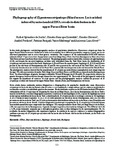Use este identificador para citar ou linkar para este item:
http://www.alice.cnptia.embrapa.br/alice/handle/doc/968951Registro completo de metadados
| Campo DC | Valor | Idioma |
|---|---|---|
| dc.contributor.author | BORBA, R. S. de | pt_BR |
| dc.contributor.author | ZAWADZKI, C. H. | pt_BR |
| dc.contributor.author | OLIVEIRA, C. | pt_BR |
| dc.contributor.author | PERDICES, A. | pt_BR |
| dc.contributor.author | PARISE-MALTEMPI, P. P. | pt_BR |
| dc.contributor.author | ALVES, A. L. | pt_BR |
| dc.date.accessioned | 2013-10-21T11:11:11Z | pt_BR |
| dc.date.available | 2013-10-21T11:11:11Z | pt_BR |
| dc.date.created | 2013-10-21 | pt_BR |
| dc.date.issued | 2013 | pt_BR |
| dc.identifier.citation | Neotropical Ichthyology, Porto Alegre, v. 11, n. 1, p. 111-116, jan./mar. 2013. | pt_BR |
| dc.identifier.uri | http://www.alice.cnptia.embrapa.br/alice/handle/doc/968951 | pt_BR |
| dc.description | In this study, phylogenetic and phylogeographic analyses of populations identified as Hypostomus strigaticeps from the upper Paraná River basin were conducted in order to test whether these different populations comprises cryptic species or structured populations and to assess their genetic variability. The sequences of the mitochondrial DNA ATP sintetase (subunits 6/8) of 27 specimens from 10 populations (one from Mogi-Guaçu River, five from Paranapanema River, three from Tietê River and one from Peixe River) were analyzed. The phylogeographic analysis showed the existence of eight haplotypes (A-H), and despite the ancestral haplotype includes only individuals from the Tietê River basin, the distribution of H. strigaticeps was not restricted to this basin. Haplotypes A, B and F were the most frequent. Haplotypes D, E, F, G, and H were present in the sub-basin of Paranapanema, two (A and B) were present in the sub-basin of the Tietê River, one (C) was exclusively distributed in the sub-basin of the Peixe River, and one (B) was also present in the sub-basin of the Grande River. The phylogenetic analysis showed that the populations of H. strigaticeps indeed form a monophyletic unit comprising two lineages: TG, with representatives from the Tietê, Mogi-Guaçu and Peixe Rivers; and PP, with specimens from the Paranapanema River. The observed degree of genetic divergence within the TG and PP lineages was 0.1% and 0.2%, respectively, whereas the genetic divergence between the two lineages themselves was approximately 1%. The results of the phylogenetic analysis do not support the hypothesis of existence of crypt species and the phylogeographic analysis confirm the presence of H. strigaticeps in other sub-basins of the upper Paraná River: Grande, Peixe, and Paranapanema sub-basins. | pt_BR |
| dc.language.iso | eng | eng |
| dc.rights | openAccess | eng |
| dc.subject | Hypostomus strigaticeps | pt_BR |
| dc.subject | Rio Paraná | pt_BR |
| dc.title | Phylogeography of Hypostomus strigaticeps (Siluriformes: Loricariidae) inferred by mitochondrial DNA reveals its distribution in the upper Paraná River basin. | pt_BR |
| dc.type | Artigo de periódico | pt_BR |
| dc.date.updated | 2013-10-21T11:11:11Z | pt_BR |
| dc.subject.thesagro | Filogenia | pt_BR |
| dc.subject.thesagro | Variação genética | pt_BR |
| dc.subject.thesagro | Peixe | pt_BR |
| dc.subject.nalthesaurus | Phylogeography | pt_BR |
| dc.subject.nalthesaurus | Mitochondrial DNA | pt_BR |
| riaa.ainfo.id | 968951 | pt_BR |
| riaa.ainfo.lastupdate | 2013-10-21 | pt_BR |
| dc.contributor.institution | RAFAEL SPLENDORE DE BORBA, UNESP, Rio Claro-SP; CLAUDIO HENRIQUE ZAWADZKI, UNIVERSIDADE ESTADUAL DE MARINGÁ; CLAUDIO OLIVEIRA, UNESP, Botucatu-SP; ANABEL PERDICES, MUSEO NACIONAL DE CIENCIAS NATURALES, Madrid, Spain; PATRICIA PASQUALI PARISE-MALTEMPI, UNESP, Rio Claro-SP; ANDERSON LUIS ALVES, CNPASA. | pt_BR |
| Aparece nas coleções: | Artigo em periódico indexado (CNPASA)  | |
Arquivos associados a este item:
| Arquivo | Descrição | Tamanho | Formato | |
|---|---|---|---|---|
| cnpasa.pdf | 1.15 MB | Adobe PDF |  Visualizar/Abrir |









